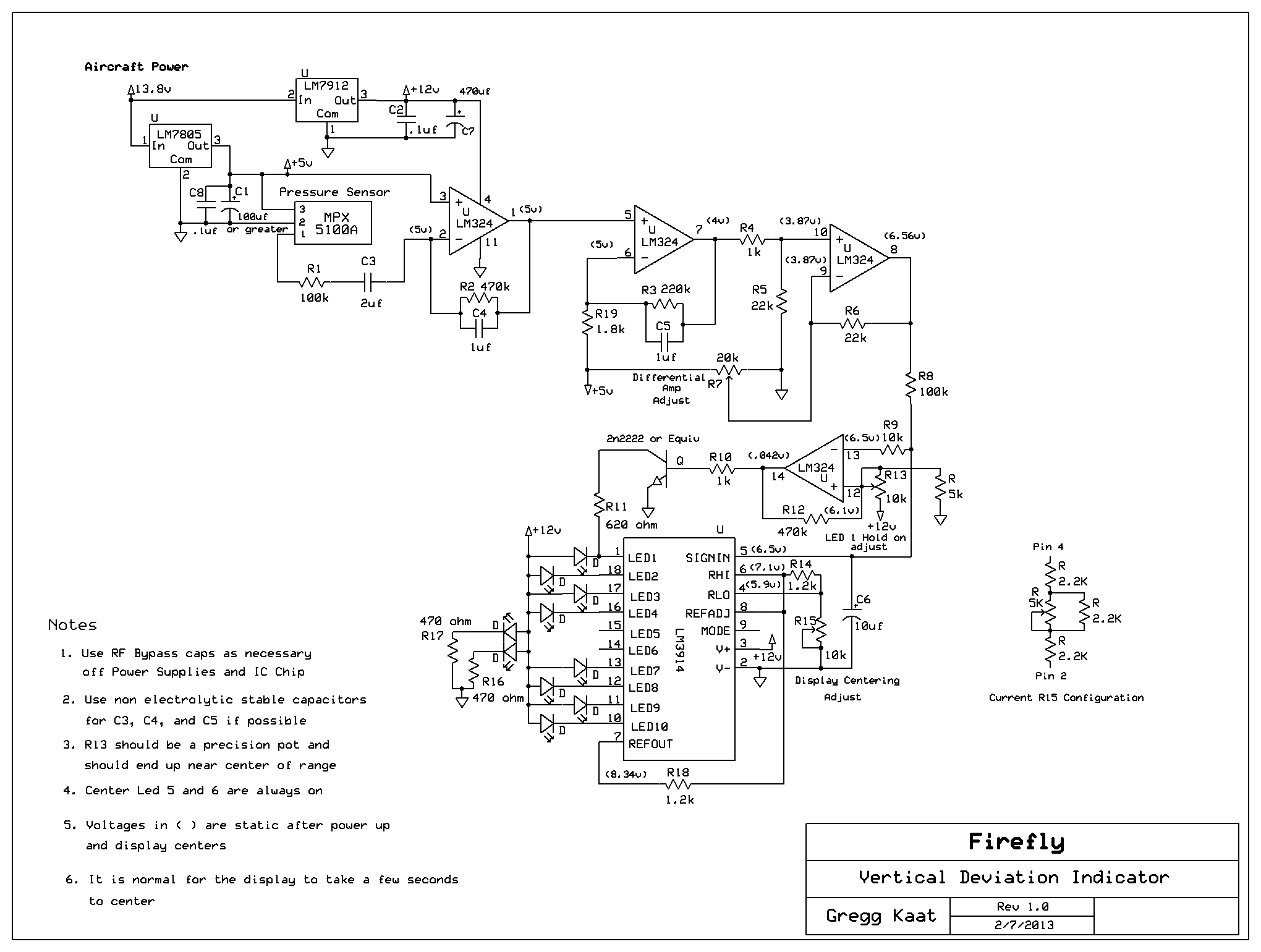This project is perhaps my most
complex and took the longest time to get it functional. It is modeled
around a variometer which is a device that Glider pilots use. Their
variometers provide an audible frequency change with changes in
altitude. I didn't want an audible tone going up and down in my headset
all the time but liked the idea of closely watching for changes in my
altitude since my plane is so light. I used this
article for a
reference and began the task. A lot of the theory of operation is
contained in that article so I'll just hit the highlights of my
changes.
I obtained the pressure sensor from ebay at a much reduced cost. Any
pressure sensor that looks up to say 10 thousand feet with an analog
voltage output could be used here. Since we are looking for a change in
altitude and not absolute altitude the sensor reading has to go back to
zero volts when there is no change. That was accomplished with an
integrator which is simply the R1, C3 combination. The voltage change
can be very small in the microvolt range or may go up to milivolts
depending on the rate of change in altitude. Therefore we need a large
amount of amplification here to be able to see it. The first 2 op amp
stages accomplish that. Now it gets a bit dicey. The third stage is a
differential amp with a lot of amplification as well. A reference
voltage is set with the R7 pot and the gain is determined by R5 and R6.
It was real touchy here to keep noise out of the circuit with too much
gain but yet have enough voltage to drive my Bargraph driver IC. If you
decide to try this, I would recommend looking at the pin 8 output with
a scope in DC mode and changing R5 and R6 if needed in case your op
amps are operating a bit differently. They must be kept equal
values though for the differential amp to work properly. The output is
fed to a Bargraph driver IC operating in dot mode so that only 1
segment lights at a time. The last op amp is just a buffer to drive a
transistor switch that holds the bottom led on if the input voltage
goes beyond the range for that segment. Full down indication is not 0
volts. This circuit operates above zero volts at all times. The
display
centering control has been replaced by an alternate circuit. Use that.
The centering control is necessary because barametric pressure changes
from day to day or even within hours so the static non-moving pressure
is changing as well. Adjusting the centering is part of the
preflight just like adjusting the altimeter. It takes up to 20 to 30
seconds after power up for the display to settle. It will
cycle through all the lights as the caps charge and the IC's settle
down. Adjust centering after that. My display is DIY made out of a
blank instrument cover plate obtained from
LEAF. I drilled 10 holes vertically through the center the size of my
leds. The 2 center leds were hard wired to be on all the time and are
green. The other leds are red. Use super bright leds here. Also, I ran
into ignition noise issues on my aircraft supply
voltage. I added an LC filter on the input to the regulator. I don't
know what the coil value is, it's just one I had lying around.
The capacitor was 470uf. LC...Coil is in series with power with
the capacitor to ground. That took care of my noise issues and my
indicator was stable after that. I use this indicator a lot and is
right in the center of my dash. You can see it functioning when you
watch my videos. This doesn't give a rate of change in ft per minute
like a regular aircraft Vertical speed does, but some intrepid
mathematician can probably figure that out and you could label your
lights wth the rates. I've tried to develop an Arduino digital version
of this using a digital barametric pressure sensor, but haven't yet
achieved a result that I like better than this one is functioning. This
indicator actually is working quite well for me. See it Here and Here.
An
Arduino version using the same analog pressure sensor used here could
be developed easier just by doing an analog read of the
sensor/integrator output and mapping a range to look at. I'll
update the page if I happen to do that in the future.
Home Page
|

